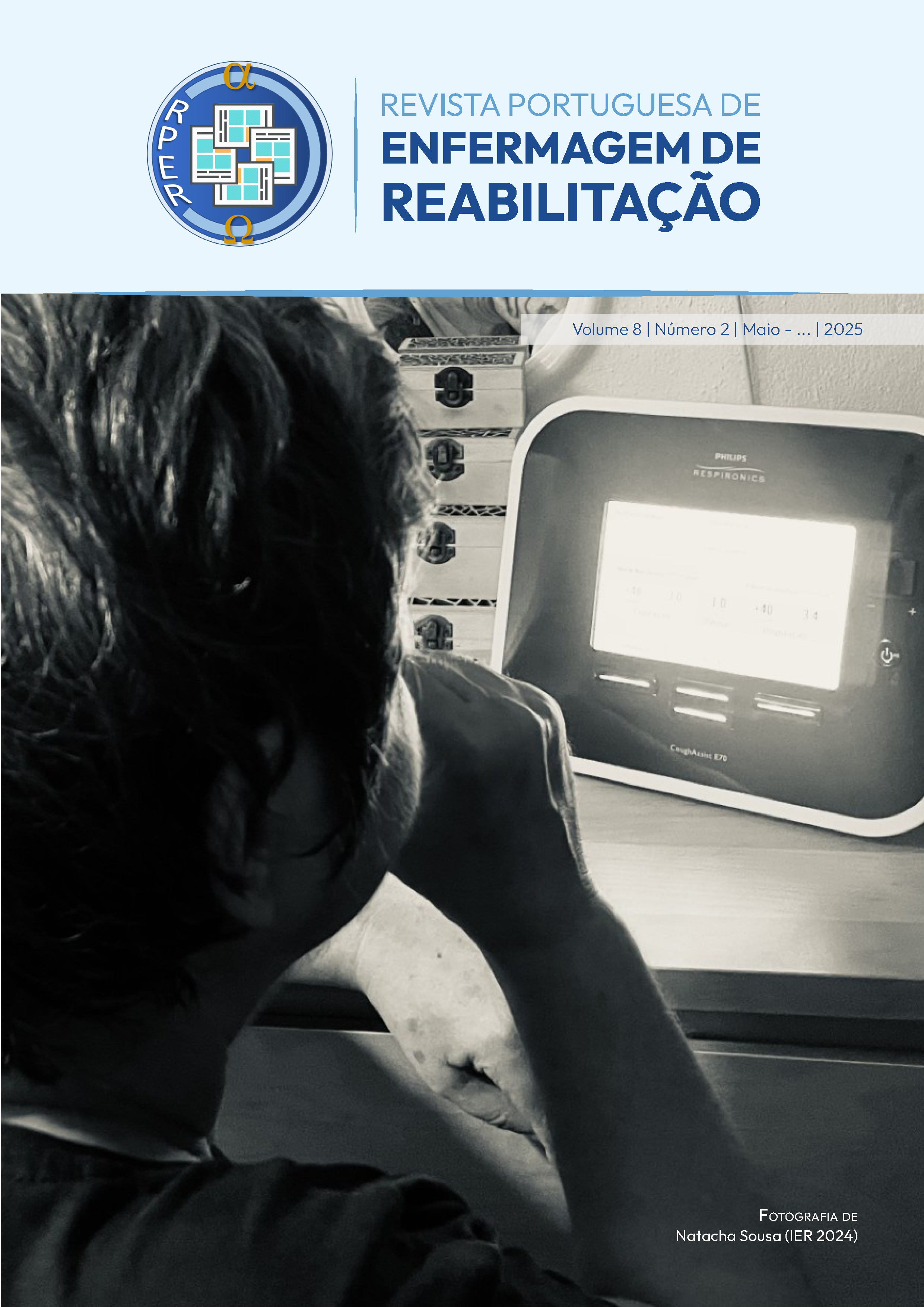Physical activity and exercise in Rehabilitation Nursing: documentary analysis based on evidence and Nursing Theories
DOI:
https://doi.org/10.33194/rper.2025.41115Keywords:
Sedentary Behavior, Rehabilitation Nursing, Functional Status, Exercise, Nursing TheoryAbstract
Introduction: Counseling and prescribing physical activity and exercise are central interventions in the practice of Rehabilitation Nursing Specialists. Aligned with international guidelines and based on Nursing Models and Theories, this practice aims to promote functionality, autonomy, and quality of life for people with rehabilitation care needs.
Objective: To discuss the advice and prescription of physical activity and exercise by Rehabilitation Nurses (RN).
Methodology: Documentary analysis of international guidelines from the World Health Organization (WHO) and the American College of Sports Medicine (ACSM), with a theoretical basis based on Nursing Models and Theories and legal references for the exercise of specialized practice in Rehabilitation Nursing.
Results: Counseling and prescription of physical activity and exercise by RN is an essential intervention in promoting functionality and autonomy, as well as in the prevention and rehabilitation of acute and chronic conditions, with a consequent impact on self-care capacity and quality of life. The RN uses approaches based on international guidelines, such as WHO and ACSM recommendations, to ensure the safety and effectiveness of counseling and prescription of physical activity and exercise. RN have specific skills that enable the design, implementation, and monitoring of physical activity and exercise programs, ensuring their adaptation to the clinical context, therapeutic objectives, and the person themselves. The theoretical foundation in Nursing Models and Theories reinforces the relevance of physical activity and exercise as a means of rehabilitation and promotion of quality of life.
Conclusion: The prescription of physical activity and exercise by RN is a practice based on scientific evidence, aligned with international guidelines, and based on Nursing Models and Theories to promote the autonomy, functionality, and quality of life of people with rehabilitation needs.
Downloads
References
Albert FA, Crowe MJ, Malau-Aduli AEO, Malau-Aduli BS. Physical Activity Promotion: A Systematic Review of The Perceptions of Healthcare Professionals. Int J Environ Res Public Health. 2020 Jun 18;17(12):4358. Available from: 10.3390/ijerph17124358
American College of Sports Medicine. ACSM’s Guidelines for Exercise Testing and Prescription, Eleventh Edition. Philadelphia: Wolters. Philadelphia: Wolters Kluwer; 2021. 0–906 p.
World Health Organization. WHO guidelines on physical activity and sedentary behaviour [Internet]. World Health Organization; 2020 [cited 2024 May 1].
Ordem dos Enfermeiros. Regulamento n.o 392/2019 - Regulamento das Competências específicas do enfermeiro especialista em Enfermagem de Reabilitação. Diário da Républica, 2a série - n.o 85 - 3 de maio de 2019. 2019. p. 13565–8.
Smith MC. Nursing theories and nursing practice. FA Davis; 2019.
Martins MM, Sousa L. Editorial. Atividade física e exercício físico: fundamentos e aplicações em Enfermagem de Reabilitação. Revista Portuguesa de Enfermagem de Reabilitação. 2019 Jun 28;2(1). Available from: 10.33194/rper.2019.v2.n1.e
Delgado B, Novo A, Lopes I, Rebelo C, Almeida C, Pestana S, et al. The effects of early rehabilitation on functional exercise tolerance in decompensated heart failure patients: Results of a multicenter randomized controlled trial (ERIC-HF study). Clin Rehabil [Internet]. 2022 Jun 21;36(6):813–21. Available from: 10.1177/02692155221088684
Preto LSR, Gomes JRL, Novo AFMP, Mendes MER, Granero-Molina J. Effects of a Rehabilitation Nursing Program on the Functional Fitness of Institutionalized Elderly. Revista de Enfermagem Referencia. 2016;4(8). Available from: 10.12707/RIV15019
Garcia S, Cunha M, Mendes E, Preto L, Novo A. Impacto de um treino propriocetivo na capacidade funcional dos idosos. Revista Portuguesa de Enfermagem de Reabilitação. 2019 Jun 28;2(1):102–7. Available from: 10.33194/rper.2019.v2.n1.12.4560
Ordem dos Enfermeiros. Guia Orientador de Boas Práticas–Cuidados à pessoa com alterações da mobilidade–posicionamentos, transferências e treino de deambulação [Internet]. Lisboa: Ordem dos Enfermeiros; 2013.
Eckstrom E, Neukam S, Kalin L, Wright J. Physical Activity and Healthy Aging. Clin Geriatr Med. 2020 Nov;36(4):671–83. Available from: 10.1016/j.cger.2020.06.009
Powell KE, Paluch AE, Blair SN. Physical Activity for Health: What Kind? How Much? How Intense? On Top of What? Annu Rev Public Health. 2011 Apr 21;32(1):349–65. Available from: 10.1146/annurev-publhealth-031210-101151
Mannakkara NN, Finocchiaro G. Exercise and the Heart: Benefits, Risks and Adverse Effects of Exercise Training. Rev Cardiovasc Med. 2023 Mar 23;24(3). Available from: 10.31083/j.rcm2403094
Sousa L, Martins MM, Novo A. A Enfermagem de Reabilitação no empoderamento e capacitação da pessoa em processos de transição saúde-doença. Revista Portuguesa de Enfermagem de Reabilitação [Internet]. 2020 Sep 16;3(1):63–8. Available from: 10.33194/rper.2020.v3.n1.8.5763
Porcelis Vargas C, Soraia Dornelles Schoeller, Milena Amorim Zuchetto, Maria Manuela Ferreira Pereira da Silva Martins, Lucas Antunes. Os Cuidados de Enfermagem de Reabilitação para o Bem-Viver. Revista Portuguesa de Enfermagem de Reabilitação. 2024 May 21;7(1):e343. Available from: 10.33194/rper.2024.343.
Downloads
Published
How to Cite
Issue
Section
License
Copyright (c) 2025 Portuguese Rehabilitation Nursing Journal

This work is licensed under a Creative Commons Attribution-NonCommercial-NoDerivatives 4.0 International License.







































